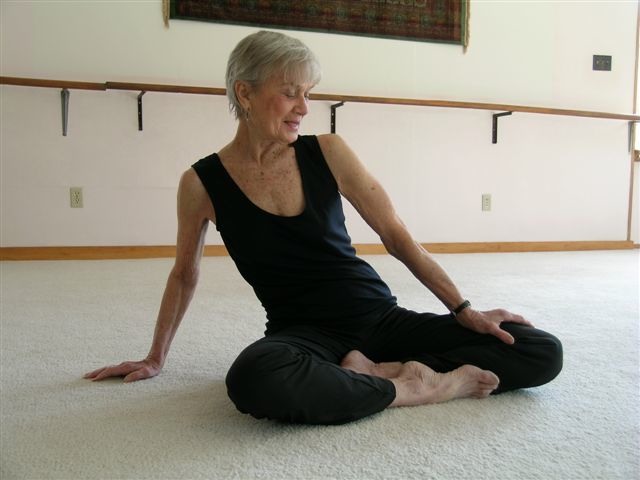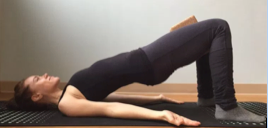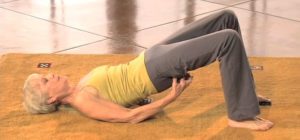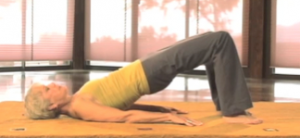In 1980, when I started teaching my program, Somatic Stretch (called BioSomatics at the time), yoga classes barely existed. The few you might find were in church basements, local shopping malls or small back rooms in some out-of-the-way buildings. Imported from the east as an authentic, five thousand-year discipline, yoga postures were taught with set guidelines in much the same way that ballet “positions” were taught in my experience of ballet. In both cases, the form, or outward appearance was the goal to be achieved in those days.
Because I had worked through structural challenges I’d had with both ballet and modern dance, I had come to an understanding that achieving the outward goal depended on whether or not one’s body was capable of conforming to the guidelines. The focus of my teaching was therefore working on the body in a way that was therapeutic and remedial, with the potential for structural transformation.
Some of the movements I had explored in years past had similarities to yoga, and when I was asked how my work was different from yoga, which happened frequently, I had a hard time explaining it. To an untrained eye, an exercise I was teaching could look like a yoga posture, but in my perception of it, it wasn’t the same.
The yoga posture above (https://yogaanatomyacademy.com/why-bridge-pose-is-not-good-preparation-for-backbends/) in combination with the two photos below is an example of the difference between the Bridge and my buttock strengthening exercise.
My observation of the Bridge is that it arches the back to one degree or another, putting some pressure into the throat area. In my buttock-strengthening version, the throat, upper chest and abdomen are all relaxed, with all of the energy going into the lower buttock muscles and not into the back. Those are the visual differences.
The intentions of the two, I believe, are also different. Not being trained in yoga, I can’t explain the purpose of the Bridge other than that it’s used for making the back flexible, with higher Bridges requiring greater flexibility. The intention of the Somatic Stretch buttock exercise is the same as for all of the strengthening exercises: to remove tension from non-working parts of the body so that maximum energy can be focused into the working, or target muscles, in this case, the buttocks. In short, the overall, authentic intention of the Bridge is to make a “shape,” while the buttock exercise has a determined, specific focal point. A by-product of this is that kinaesthetic awareness can be developed through feeling the body working in this localized way.
That said, it’s interesting to note that over the years yoga has been shifting away from its traditional parameters and widening into areas that are more somatic, so the differences are becoming more blurred. An article on the Yoga Anatomy Academy website, from which the top photo was copied, states that the Bridge “can be used in a physical asana practice for a number of distinct purposes. For example, a physical therapist or personal trainer might use it to strengthen gluteal muscles, quads, hamstrings or lower back muscles, just to name a few possible targets (with small tweaks to the exercise to more meaningfully engage each).”
The mention of “small tweaks” in the above paragraph is what brings the Bridge closer to a somatic exercise, although tweaking an exercise is different from creating an exercise for a specific purpose. The buttock exercise shown is one of a series in Somatic Stretch for strengthening the buttocks, in particular, the bottom portion of the buttocks. (See the second photo where my hand is squeezing the lower end of the buttock.)
The greater purpose of strengthening this lower part of the buttocks is because contracting these muscles, in combination with pushing with the back foot, is what moves the body forward from the hips (that is, pelvis) when walking—rather than stepping forward with one foot and “catching your body up to it.” Walking the latter way is fine when you’re ambling but it doesn’t provide any momentum when you want to walk quickly or take long strides.That requires the separate parts of the body to be internally aligned and the energy centre in the abdominals activated, that is, the abdominals should be engaged so they, in fact, carry the body forward with help from the buttock and foot.
“The devil is in the details” is how I saw the difference between my exercises and yoga back in the 80s but I didn’t know how to explain it in the activity-oriented times. Today it’s still the same difference though to a lesser extent because of the somatic influence, but now I explain it as the difference between working externally, where you’re copying a picture or a drawing, or what someone is demonstrating, to working internally, where you’re connected with the actual muscles you’re working with on a conscious level. This is what gives you control over how you use your body, like knowing which strings to pull on a puppet to move its body parts and limbs.
The even more overall purpose of Somatic Stretch exercise is to connect with our bodies and to “know” them so well that we can make them physically able and useful in all that we do, and beyond that, as comfortable and pain-free as possible so that living our earthly existence can be as pleasurable as we would want it to be.
With that in mind, here’s the way to do the Somatic Stretch exercise for strengthening the buttocks as taught through close to four decades:
- Lie on your back with your lower back flat, knees bent and feet and knees hip-width apart; arms are on the floor at your sides, palms down.
- Breathing out through your mouth, stand on your feet to lift the back of your pelvis off the floor in a slight pelvic tilt, feeling your belly flatten.
- Push your heels against the floor, tightening the muscles at the bottom of your buttocks—where they connect to your hamstrings—to push your pelvis up into your hip joints. (See where my hand is squeezing the buttocks.) Thinking of pushing your pubic bone up can tighten the buttocks even more. The abdomen should still feel flat and “sunk” into the pelvic bowl so the lower back doesn’t arch.
- Keep the buttock muscles contracted and pushing the pelvis upward until they tire. The abdomen should still feel flat and sunk into the pelvic cavity so the lower back doesn’t arch.
- Very slowly lower the pelvis to the floor so you feel the individual muscles releasing. Once on the floor, slowly relax the muscles completely.
This exercise can be done as many times as you want, staying each time until the muscles tire. In the beginning this may not take very long, but with repeated use the muscles will strengthen so you can stay longer, which will strengthen them even more. In time, it will become natural to use them when you’re walking.
When you do the exercise for the first time, or only occasionally, your buttocks can feel “sore” the next day, but that’s a good sign. It means you’ve got them working. And as you keep working this way, you should notice that you’ve developed a much firmer “butt” in the process.
You can find this exercise along with many others that focus on improving a particular aspect of the body in the videos here.
This article is intended for informational purposes only. If you have any questions or are considering any recommendations, please consult your health practitioner.




























